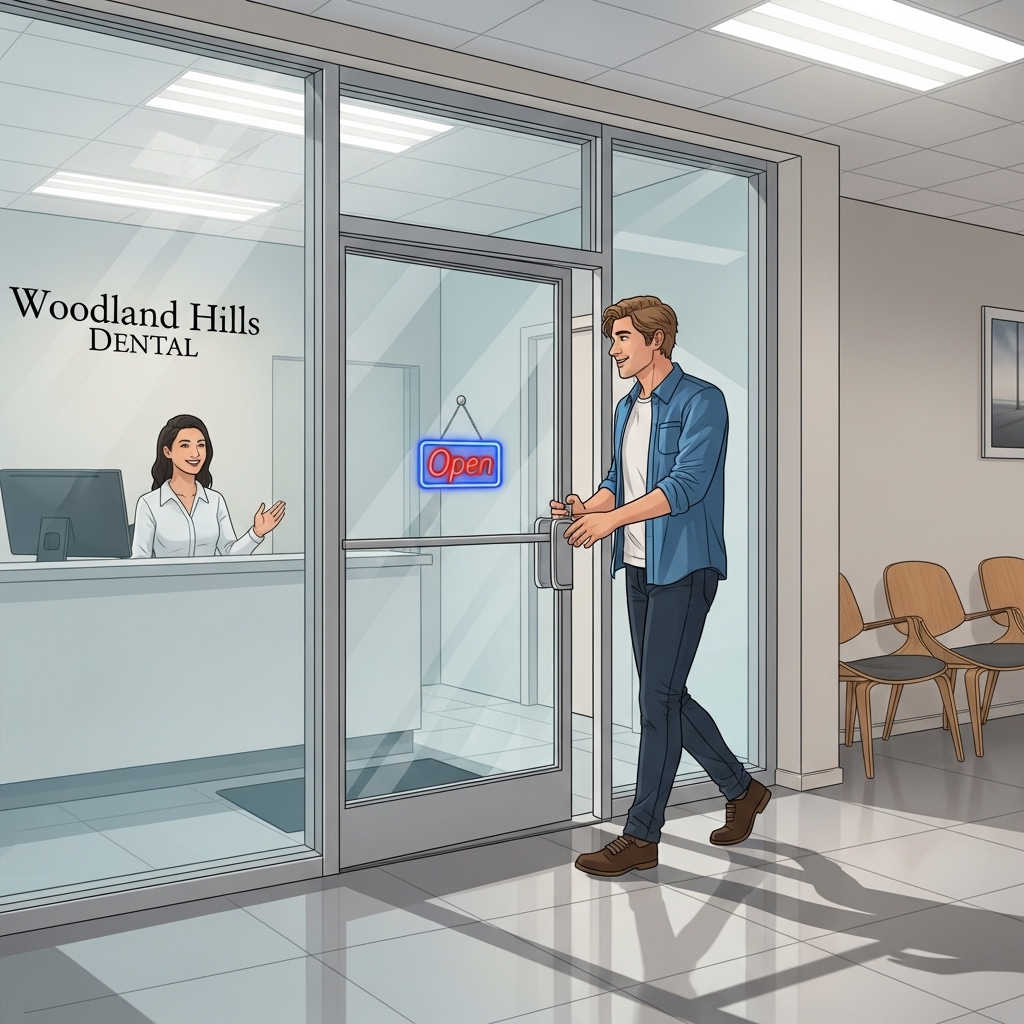Some days in Woodland Hills move quickly and smoothly—coffee on Ventura Boulevard, a productive morning, and a sunset walk as the heat eases. Then there are days when everything changes with one bite into a crusty lunch sandwich or an unexpected slip during an afternoon activity. A sudden crack, a zing of pain, a broken filling, or a tooth that just feels wrong can disrupt your plans and your peace of mind. In those moments, the most comforting phrase you can hear is “We can see you today.” Same-day, walk-in emergency dental care takes an urgent problem and transforms it into a clear, manageable path. And when that care is local, you avoid long drives and long waits, which is exactly what you need when you are hurting. From experience helping Woodland Hills residents, I can say that access to a responsive emergency dentist makes the difference between a day defined by anxiety and one defined by relief.
Walk-in availability is more than an open door; it is a philosophy. It means designing the schedule with built-in flexibility, training the team to triage on the fly, and developing efficient treatment protocols that stabilize a situation quickly without compromising quality. In a community as active as ours—where kids go straight from school to sports, professionals squeeze errands between meetings, and families make the most of sunny afternoons—emergencies can’t always be planned, but they can be handled promptly.
Why Same-Day Matters in Real Life
Dental pain has a knack for snowballing. What starts as a dull ache can escalate into sharp, sensitive, even throbbing sensations that overshadow everything else. A broken tooth may feel jagged and intrusive, making it hard to speak and eat. Even if the problem seems minor, the uncertainty can be just as unsettling: Will this get worse? Can it be fixed quickly? Will I be able to get back to work today? Same-day care provides answers, relief, and a plan. You walk in worried and walk out knowing exactly what happened, what was done, and what comes next.
In Woodland Hills, timing is often the difference between catching a problem before evening traffic or losing a full day juggling calls and schedules. A practice focused on same-day care anticipates these realities. The team is ready to pivot, to fit you in, and to communicate clearly what you can expect. This agility is not luck; it is built on systems that value responsiveness and patient-centered care.
What Happens When You Walk In
From the first greeting, walk-in emergency care feels different. You will be asked to describe your symptoms—how they started, what makes them worse or better, and whether there was trauma. Staff trained in triage will identify red flags like swelling, fever, or signs of infection, and they will prioritize your visit accordingly. A focused clinical exam, often paired with targeted digital X-rays, helps the dentist pinpoint the source of your discomfort. Clarity leads to action, and action leads to relief.
Depending on the situation, same-day treatment may include smoothing a sharp edge, placing a temporary or definitive filling, securing a loose crown, medicating an inflamed nerve, draining an abscess, or stabilizing injured tissues. Even when a complex procedure is ultimately required, the immediate goal is to end pain, reduce risk, and create a bridge to definitive care. You will leave with written instructions and a follow-up plan that fits your schedule.
Common Walk-In Emergencies We See in Woodland Hills
Every day brings a different story. A busy professional cracks a molar on a hard snack between meetings. A teen takes a ball to the mouth at practice. A parent notices growing tenderness that turns into a pulse of pain after a hot drink. Lost fillings, chipped enamel, gum swelling, broken crowns, sensitivity from exposed dentin, and lingering pain from clenching at night are frequent culprits. The diversity of these cases underscores the value of a team that can shift gears quickly and tailor solutions in the moment.
While not every emergency is dramatic, all deserve attention. Ignoring a problem rarely makes it better. Early intervention preserves options—saving a tooth that might otherwise be lost, keeping treatment simpler, and preventing cascading issues that would pull more time from your week.
The Comfort Factor: Ending Pain and Easing Anxiety
When you are in pain, speed matters—but so does how you are treated. A calm, organized process lowers stress. Gentle techniques, effective anesthesia, and clear explanations help you regain a sense of control. If you have dental anxiety, say so; there are ways to support you that make a world of difference. Many patients are surprised by how manageable urgent care feels when they are guided step by step through what will happen and why.
Communication is not just about the procedure; it is about what comes next. You should leave with a practical, easy-to-follow plan. If a temporary solution is in place, you will know how to protect it. If infection was present, you will understand warning signs to watch for and when to return. These details transform a chaotic day into a sequence of manageable steps.
Why Local Walk-In Care Beats Waiting Days Elsewhere
Choosing a Woodland Hills provider with same-day walk-in availability means you can act on your instincts. Instead of delaying and hoping the pain disappears, you can head in right away. Being close to home matters, especially when you are uncomfortable. Short travel times and familiar surroundings make urgent care less daunting. A local team can also collaborate quickly with nearby specialists if needed, ensuring that any handoffs happen smoothly without sending you on a confusing scavenger hunt across the city.
Another advantage of local walk-in care is continuity. The same people who help you through today’s emergency are there to oversee your recovery and guide your preventative care. This consistency not only saves time, it builds trust. Over time, you learn how the team works and they learn how to anticipate your needs.
Protecting a Broken Tooth Before You Arrive
If you chip or crack a tooth, rinse your mouth gently with warm water and avoid chewing on the affected side. If the edge is sharp, place dental wax over it if you have it. Save any fragments you can in a small, clean container. If a crown comes off, keep it safe, and avoid strong adhesives. Arriving with these details handled speeds up the process and can improve outcomes.
If a tooth is knocked out entirely, handle it by the crown—not the root—and try to reinsert it gently. If this isn’t possible, store it in milk or in your cheek to keep it moist until you can be seen. These steps buy time and protect delicate tissues that are key to saving the tooth.
Same-Day Care for Kids, Teens, and Adults
Because emergencies don’t respect age, a walk-in system must adapt to different needs. Children need gentle language and a soothing pace. Teens may want clear, direct explanations and reassurance about appearance and school. Adults often prioritize getting back to work quickly and understanding how to prevent a repeat event. The best same-day care balances empathy with efficiency across all ages.
Beyond the visit itself, thoughtful follow-up matters. A check-in call can confirm that pain is under control and that instructions are clear. It also creates space to ask questions you may not have thought of at the appointment, once you are more comfortable and settled.
Midday, Evening, or Weekend: A Plan That Works on Your Time
Emergencies can arrive at any hour. While walk-in availability is most robust during the day, the right practice also offers clear pathways for after-hours guidance. That may include on-call support to help you decide whether to come in immediately, protect the area at home, or schedule first thing the next morning. This flexibility ensures that your relief does not depend on perfect timing.
For Woodland Hills residents juggling work across the Valley and family commitments, having both walk-in and guided after-hours options means you are never left guessing. You can move from pain to plan, regardless of the clock.
From Stabilization to Long-Term Strength
Same-day solutions are the first step, not the last. Once your pain is controlled and the immediate risk is addressed, you will discuss durable options to restore strength and function. That may involve replacing old fillings, strengthening a fractured tooth with a crown, or addressing clenching and grinding with a nightguard. A measured, staged plan often works best, letting you heal comfortably while fitting care into your schedule.
As relief sets in, you will have the bandwidth to ask broader questions: Why did this happen now? What can I change in my routine to reduce risk? Are there early signs I missed? Your dentist should welcome those questions and translate them into practical steps that fit your life in Woodland Hills.
Frequently Asked Questions About Walk-In Emergency Care
Below are answers to common questions that Woodland Hills residents ask when emergencies occur at inconvenient times. Refer back to these whenever you need a quick reminder of what to do.
Can I just show up, or should I call first?
If you can, call on your way so the team can prepare and advise you on immediate steps. However, if calling is not an option, walk in—urgent needs deserve prompt attention, and a good system is designed to adapt quickly.
What if I don’t have my records with me?
Don’t let that stop you. A focused exam and targeted imaging can provide the information needed to address urgent issues. Your records can be requested later for continuity of care.
Will I receive definitive treatment the same day?
Often, yes—particularly for smoothing sharp edges, replacing small fillings, stabilizing crowns, and managing inflamed or infected tissue. Complex cases may require a staged approach, but same-day relief and stabilization are typical goals.
How long will I wait as a walk-in?
Waiting times vary based on the day’s schedule and the urgency of your symptoms. Practices that prioritize walk-ins reserve time for emergencies, which minimizes delays and helps you return to your day.
What if my child has a dental emergency after school?
Call for immediate guidance and head in. Kid-friendly communication, gentle techniques, and quick stabilization are central to effective pediatric emergency care. You can expect clear instructions tailored to your child’s age and needs.
How can I prevent needing walk-in care again?
Regular checkups, updated restorations, mouthguards for sports, nightguards for clenching, and mindful daily habits reduce the chance of surprise problems. Prevention will save you time and discomfort in the long run.
If you are hurting right now, you don’t have to wait days for help or drive across town searching for solutions. Head to a trusted Woodland Hills emergency dentist for same-day, walk-in care, get answers in real time, and leave with a plan that restores your comfort and confidence.





